HIGHWAY ENGINEERING AUSTRALIA

TRANSPORT INFRASTRUCTURE ITS TECHNOLOGY


SINCE 1968

FEB/MAR 2023 PROUDLY SUPPORTED BY
PRINT POST APPROVED - 100001888
V54.2
The 2023 TMAA Conference is the premier Traffic Management event for 2023, and a must for all traffic management industry professionals.
Featuring presentations by key international and local industry experts, this Conference will define industry sustainability working through pre-qualification, training, recruitment and career pathing.

Delegates will also be able to gain valuable insight into the latest in operational systems and safety solutions, which will be on show at the accompanying exhibition.
For more information, including the Conference Program, as well as bookings and accommodation packages, visit: www.tmaaconference.com.au






Published by: Editorial and Publishing Consultants Pty Ltd ABN 85 007 693 138 PO Box 510, Broadford Victoria 3658 Australia Phone: 1300 EPCGROUP (1300 372 476) Int'l: +61 3 5784 2210 www.epcgroup.com Publisher and Managing Editor Anthony T Schmidt Phone: 1300 EPCGROUP (1300 372 476) Mobile: 0414 788 900 Email: ats@epcgroup.com National Advertising Sales Phone: 1300 EPCGROUP (1300 372 476) Int'l: +61 3 5784 2210 Email: ats@epcgroup.com Business Development Manager Lawrence Whiter Mobile: 0418 543 821 Email: lawrencewhiter@bigpond.com Advertising Sales - SA Jodie Gaffney - AmAgo Mobile: 0439 749 993 Email: jodie@amago.com.au Advertising Sales - WA Licia Salomone - OKeeffe Media Mobile: 0412 080 600 Email: licia@okm.com.au Graphic Design Annette Epifanidis Mobile: 0416 087 412 Registered by Australia Post Publication No. 100001888 ISSN 0046-7391 TERMS AND CONDITIONS This publication is published by Editorial and Publishing Consultants Pty Ltd (the “Publisher”). Materials in this publication have been created by a variety of different entities and, to the extent permitted by law, the Publisher accepts no liability for materials created by others. All materials should be considered protected by Australian and international intellectual property laws. Unless you are authorised by law or the copyright owner to do so, you may not copy any of the materials. The mention of a product or service, person or company in this publication does not indicate the Publisher’s endorsement. The views expressed in this publication do not necessarily represent the opinion of the Publisher, its agents, company officers or employees. Any use of the information contained in this publication is at the sole risk of the person using that information. The user should make independent enquiries as to the accuracy of the information before relying on that information. All express or implied terms, conditions, warranties, statements, assurances and representations in relation to the Publisher, its publications and its services are expressly excluded save for those conditions and warranties which must be implied under the laws of any State of Australia or the provisions of Division 2 of Part V of the Trade Practices Act 1974 and any statutory modification or re-enactment thereof. To the extent permitted by law, the Publisher will not be liable for any damages including special, exemplary, punitive or consequential damages (including but not limited to economic loss or loss of profit or revenue or loss of opportunity) or indirect loss or damage of any kind arising in contract, tort or otherwise, even if advised of the possibility of such loss of profits or damages. While we use our best endeavours to ensure accuracy of the materials we create, to the extent permitted by law, the Publisher excludes all liability for loss resulting from any inaccuracies or false or misleading statements that may appear in this publication. Copyright ©2023- EPC Media Group About the Cover Adelaide-based traffic management company Workzone Traffic Control continues to go from strength to strength, with two new divisions - Workzone Training and Workzone Safety & Signage – as well as a new traffic business (Workzone Territory) to service clients across the Northern Territory. Turn to Page 12 for the full story. 2 Editor’s Column 4 Industry News 12 Cover Feature: Workzone Traffic Control 18 Product Focus: Aussie Pumps 22 Road Safety 28 Electric Vehicles 30 Innovative Solutions 32 National Precast News 34 Equipment Focus 38 NTRO | ARRB News 4 22 32 38 contents FEB/MAR 2023 Volume 54 Number 2
OUR HIGH-TECH TRANSPORT FUTURE HAS SOME CRITICAL ‘LOW-TECH’ NEEDS
Dear Readers,
As many of you would know, Highway Engineering Australia (HEA) has been a long-time supporter and advocate for the introduction and expansion of Intelligent Transport Systems (ITS) technology across our road and transport network.
Sparked by my long-term professional involvement with the IT sector (as well as my undeniable fascination with all things high-tech), I believe that recent years have clearly demonstrated the potential of ITS technologies to deliver significant improvements in efficiency and productivity across the majority of industry sectors, while also improving safety, reducing travel times and reducing the environmental impact of transport and freight in general.
While I’m clearly in the ‘pro ITS technology’ camp, I also believe that we, as a nation, have a significant infrastructure issue that must be addressed before we can even begin to consider the widespread introduction of much of this technology – particular in terms of automated vehicle guidance technologies.
The issue to which I am referring is, perhaps not surprisingly, the quality of our road network infrastructure… in this instance, more specifically, the quality of line marking and road markings (or lack thereof).
Put simply, as much as I (and many others I’m sure) would love to see the establishment of integrated ITS technologies across the country - including the technologies required to facilitate autonomous vehicles – the sad fact
is: much of our road network is simply not up to the task.
Indeed, most of our major capital cities still have sections of unmade road within their greater metropolitan boundaries. And as for the quality of the paved road network, much of it is in dire need of repair or replacement.
That said, for the purpose of this editorial, I’m not referring to the quality of the pavement.
A number of critical ITS technologies - including many of the ‘driver assist’ technologies such as ‘lane departure warning systems’ now being included as standard features in many new car models – rely on quality line marking and road markings to establish the vehicle’s physical position on the road.
While I’m not about to start a blame game for the poor quality of much of the line marking on our road network (after all, attempting to apportion blame does nothing to solve the issue), it’s clear that something needs to be done.
In short, without the critical ‘low-tech’ components of quality pavements and high quality, clearly visible line marking, many of the high-tech components simply won’t function.
Please don’t misunderstand, I’m not for one moment suggesting that we slow down on the development and implementation of ITS technology so we don’t end up trying to put the ‘cart before the horse’ – quite the contrary.
What I’m suggesting is that with ITS technologies moving forward at such a rapid rate of knots, we need to really step
up our game in terms of road maintenance – especially when it comes to improving the quality and consistency of line marking.
While there finally seems to be a widespread agreement on the value of investing in road infrastructure as a key component to a strong economy, it seems that in the rush to expand our network and increase capacity, the more mundane but highly necessary tasks – such as ensuring that ALL roads across the network have clearly visible and compliant line marking and road markings – are in danger of once again being relegated to the ‘back-burner’. We must not let that happen.
Poor quality and non-compliant line marking and road markings are not only a hazard to road users, they are also completely useless when it comes to providing what’s needed for many ITS technologies. What’s more, the longer you leave them, the worse they get.

That said, I believe that now is the perfect time to address this most critical issue. After all, ‘there’s no time like the present’ when it comes to critical infrastructure tasks – and high quality line marking and road markings are the ‘low-tech’ key to many of the high-tech ITS solutions that will carry us into the future.
Anthony T Schmidt Managing Editor
2 Highway Engineering Australia | Feb/Mar 2023 EDITOR’S COLUMN
Introducing Ezy-Guard High Containment, a member of the next-generation Ezy-Guard barrier family, providing superior motorist safety. Ezy-Guard HC is proven and crash tested to the latest MASH Test Level 4 standard, distinguishing it from all existing public domain guardrail barrier systems in Australia.

• Crash tested to MASH Test Level 4
10,000kg Truck
• Narrow footprint saving road width
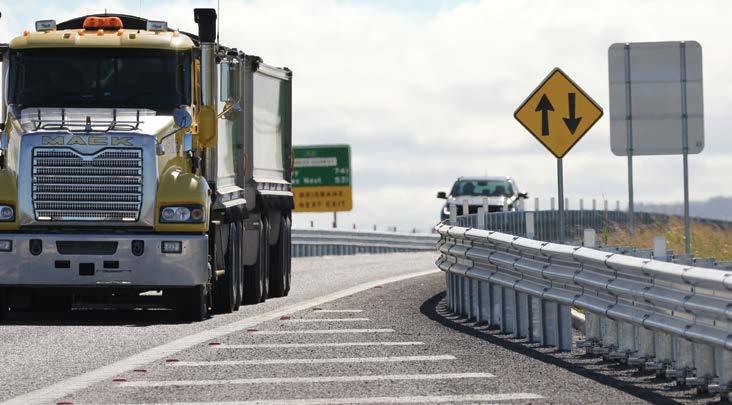
• Easy to transport and simple to install
• Consideration for motorcyclists with rounded post corners
• Can be installed as a post-on-baseplate for areas where underground services restrict posts from being driven into the ground

Ref: PP0615 www.ingalcivil.com.au sales@ingalcivil.com.au
• Sydney (02) 9827 3333 • Brisbane (07) 3489 9125 • Melbourne (03) 9358 4100 • Adelaide/NT 0438 153 482 • Perth (08) 9452 9111 • Newcastle 0400 235 883 • Wagga 0427 779 588 • Local call 1300 446 425 INGAL
High-Containment Roadside Safety Barrier
CIVIL PRODUCTS
Consideration for motorcyclists Narrow footprint saving road width Baseplated installation Australian Made MASH TL4 MASH TL3 MASH TL4: 10,000kg Truck + 2,270kg Utility
–
TL4 1.20m TL3 1.16m Ezy-Guard HC Deflections at 2m Post Spacing
in Victoria
The Victorian State Government has introduced a new in-built security feature in general-issue number plates, which will reduce crime and number plate theft and benefit all Victorians. Rolled out from Friday, 30 December, the Directional Security Markings embedded in the surface of new general issue number plates will provide an extra level of authentication, making it harder for them to be illegally copied.
VicRoads has been working closely with Victoria Police and the Department of Justice and Community Safety on a solution to combat number plate theft and cloning.

Speaking about the new plates, Victorian Minister for Roads and Road Safety, Melissa Horne, commented:
“We have been working closely with relevant departments on a solution to address number plate theft, and it is fantastic that we can now begin delivering this new technology.”
With growing number plate theft in Victoria, the new design features a ‘VIC’ logo within a small circle – with the security markings unable to be removed by chemical or physical means from the sheeting or finished sticker without causing irreparable damage to the reflective system. This new style plate aims to stop criminals creating duplicate number plates and placing them on a vehicle of the same make and model as the original, avoiding apprehension for any crimes they commit while driving that vehicle.
The markings are similar to holograms embedded in the production of Australian banknotes and will ensure that unauthorised reproduction of number plates is impossible.
“We know that number-plate theft has been a growing problem in Victoria – these new Directional Security Markings add an additional layer of security that will stop theft and help reduce crime,” added Victorian Minister for Police, Anthony Carbines.
The new security markings will appear on about 430,000 new number plates per year, including all general issue standard car number plates, trailer number plates, Commonwealth Government “Z” number plates and Ministerial number plates.
Victorians will see the new number plates released gradually as new vehicles are registered, and new number plates are issued.
There will be no extra cost to drivers who order standard-issue plates with new security markings.
Truckies to help shape rest stop plans across NSW
The NSW State Government is encouraging truckies and the freight industry to participate in consultation to improve heavy vehicle rest stops across the state.
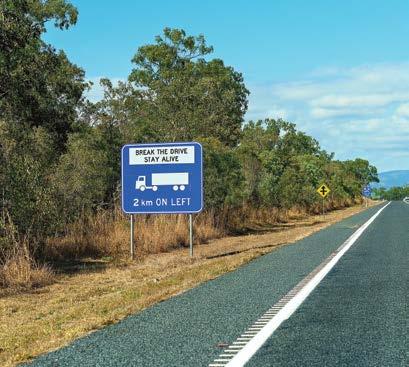
New South Wales Minister for Regional Transport and Roads, Sam Farraway, said the initiative was important because it would help the government address gaps in the rest stop network and ensure facilities meet the needs of drivers.
“The road freight industry is critical to our state’s economy, from big business and farmers to retailers and consumers. We all rely on these drivers to ensure our goods get to us quickly and efficiently,” Mr Farraway said.
“It is important that we provide quality facilities that support heavy vehicle drivers and improve road safety. Up north in Clybucca we have installed outdoor fitness equipment for truckies to use so they can stretch and get exercise in after a long period on the road.”
“The NSW freight task is expected to grow by 34 per cent by 2061 and the Government is doing everything to support this growth, which will ensure our supply chain is efficient, our economy is strong and our future bright,” the Minister said.
“We have several projects underway investigating, planning, designing and constructing heavy vehicle rest stop improvements. Industry feedback is guiding this work to ensure it meets the current and future needs of heavy vehicle drivers and the growing freight task,” he added.
“We want to hear from the road freight industry, particularly heavy vehicle drivers on what they need and expect at rest stops across NSW and where additional facilities are needed.”
The Livestock, Bulk and Rural Carriers Association President Wade Lewis welcomed the continued progression of the NSW Heavy Vehicle Rest Stop program, which will provide new and upgraded rest areas for heavy vehicles on key freight routes in NSW.
“Rest areas are a vital component of the heavy vehicle task and support drivers to manage fatigue and comply with driving hours regulation,” Mr Lewis said.
“The NSW Heavy Vehicle Rest Stop program highlights the commitment by the NSW government to engage with industry to develop a practical and capable rest area network.”
Feedback is being encouraged via the website: https://www.haveyoursay.nsw.gov.au/heavy-vehicle-rest-stops
Safer number plates to help reduce crime
4 Highway Engineering Australia | Feb/Mar 2023 INDUSTRY NEWS





THE EQUIPMENT YOU NEED – THE SERVICE YOU EXPECT A1 Roadlines Pty Ltd | 89 Rushdale Street, Knoxfield, Victoria 3180 | www.a1roadlines.com.au P: 1300 217 623 (A1ROAD) | E: sales@a1roadlines.com.au
New CEO announced for the Traffic Management Association of Australia (TMAA)
During January, the Traffic Management Association of Australia (TMAA) announced the appointment of Matthew Bereni as its new Chief Executive Officer. Mr Bereni brings a wealth of experience and leadership skills to the association and will be responsible for driving the company's strategic vision and growth.
The appointment, finalised by TMAA’s Board of Directors in December 2022 sees, Matthew Bereni take on the role from outgoing CEO Louise Van Ristell, who stepped down in November 2022.
“We are thrilled to welcome Matthew to the TMAA team,” said Andrew White, TMAA President.
“His extensive experience in government and the transport industry and his proven track record of successful organisational transformation make him the ideal candidate to lead our association into the future. We are confident that Matthew will take TMAA
to new heights and that the association will continue to grow under his leadership.”
“I would also like to acknowledge Louise Van Ristell and thank her for the contribution and leadership she has provided to the organisation over the past 11 years,” Mr White added.
Speaking about his appointment, Mr Bereni said he is honoured to join TMAA and lead such a talented team.
"TMAA advocates for excellence and safety for the traffic management industry, which is very appealing to me,” he said.
“I look forward to working closely with the board, employees, and current and future members to build upon the strong foundation that has been established by the Board and the previous CEO, and to capitalise on new opportunities for growth and success.”
TMAA is the national peak body for Traffic Management. It represents the Traffic Management and Traffic Control industry throughout Australia.
Traffic management companies and traffic controllers across the country work in a range of multi-billion dollar infrastructure, recovery, relief and rebuild projects. The industry employs about 300,000 traffic controllers and provides work on roads, construction, events, utilities, reconstruction and emergency and disaster relief.
For more information, please visit: www.tmaa.asn.au
New guideline helps driver licensing authorities test drivers using vehicles with ADAS

Austroads has published a new Guideline to assist driver licensing authorities to develop responses to the increasing presence of Advance Driver Assistance System (ADAS) functions in vehicles used for training and testing new drivers. The Guideline will also be of interest to driver trainers and assessors who may need to consider how they respond to driver licence testing with ADAS functions.
“ADAS functions have become standard in many new cars, offering new safety features that benefit everyone on the road,” said Austroads Road Safety and Design Program Manager, Michael Nieuwesteeg.
“Understanding what these features do and how the driver should use them is crucial to getting the best safety outcomes from this technology.”
The Guideline provides a brand-neutral list of ADAS functions found in vehicles in the Australian car fleet. High-level, simplified descriptions outline how ADAS functions work, what they do and what they do not do, their benefits and limitations and what safety improvements those functions might provide.
The Guideline also assesses the safety value of the ADAS functions and their suitability for use in driver testing.
“We intend this Guideline to be a first step in building harmonisation in the states and territories’ incorporation of ADAS functions in driver licence testing,” Mr Nieuwesteeg said.
“Ultimately, Austroads is supporting its members to improve the understanding of ADAS functions among owners and drivers, helping them to get the best out of their vehicles.”
About Matthew Bereni
Matthew has extensive industry and leadership experience in the public and private sectors in civil and transport engineering.
Prior to joining TMAA, Matthew held the role of National Director of Strategy & Innovation with the Australian Road Research Board (ARRB).

Matthew’s previous roles included Manager of National Harmonisation at the National Heavy Vehicle Regulator (NHVR) and Manager of Pricing and Economics at the National Transport Commission (NTC).
Matthew is a graduate of the Australian Institute of Company Directors and has Honours Masters degrees from ‘École des Ponts ParisTech’ and ‘Ecole Nationale des Travaux Publics de l'Etat’, France and from Imperial College London.
The underlying technology, terminology and deployment of ADAS functions are constantly changing. The Guideline will be subject to those changes and will be regularly reviewed and updated.
“We are planning to release a Consumer Guide in 2023 that will help vehicle drivers and owners understand the ADAS functions available in their vehicles,” Mr Nieuwesteeg added.
6 Highway Engineering Australia | Feb/Mar 2023 INDUSTRY NEWS
Reminder for engineers working in Victoria to register now
Engineers Australia has issued a reminder of the upcoming Victorian requirement that electrical and electronics engineers must be registered in order to work in the state.

From 1 June 2023, electrical and electronics professional engineers practising in Victoria must be registered, including engineers living in other states and territories but working on projects in Victoria.
Engineers Australia is urging engineers to complete the first step of applying for a competency assessment by March 2023 at the latest.

To support electrical and electronics engineers to get a better understanding of who needs to be registered and what they need to do, Engineers Australia is running a free information session specifically on Victorian registration March 1st.
The session will provide information about registration requirements and competency assessments. Attendees will also be able to ask Engineers Australia’s team of experts any questions about the assessment and registration process.
Engineers Australia Chief Engineer Jane MacMaster said the compulsory registration of professional engineers will enable significant enhancement of public safety and consumer confidence.

“Registration helps to ensure that only those with suitable qualifications, enough relevant experience and a proven commitment to ongoing training and professional development can provide engineering services,” she said.
Registration of engineers in Victoria is carried out by the Business Licensing Authority (BLA); however, an applicant must first be assessed by an approved entity, of which Engineers Australia is one. The assessment process has two components:
• An ‘Entry to Practice’ assessment to determine the adequacy or otherwise of the applicant’s qualifications.
• An ‘Independent Practice’ assessment to determine the acceptability or otherwise of the applicant’s experience and competency.
Engineers Australia is advising engineers to start the registration process at least three months prior to the date by which they are required to be registered. This will help to ensure engineers can continue to provide professional engineering services in Victoria. It will allow six to eight weeks to gain an assessment from Engineers Australia and 28 days for the Business Licensing Authority (BLA) to process the application (as recommended by BLA).
For further information, please visit: https://www.engineersaustralia.org.au/get-assessed-victoria


ü 5 year pump warranty 4" TRASH PUMP ... DIRTY WATER SPECIALIST ü Self priming to 7.6m ü Fast, easy set up ü Flows to 1,600 lpm ü 10HP Yanmar diesel
DIESEL
Australian Pump Industries Aussie Pumps 02 8865 3500 aussiepumps.com.au AUSSIE PRODUCTION SOARS we’reforAustralia 1300 240 337 www.enviroblast.com.au EnviroBlast Australia Mobile Media Blasting - Soda & Garnet • Specialising in Concrete preparation for Carbon Fibre application • Abrasive & Non-Abrasive Blasting
Paint, rust & contaminant removal from many substrates
Line marking removal
Graffiti removal & protection
Removal of sealers & coatings
Creation of non-slip surfaces
Compact machinery for easy access
Low media usage which means less environmental issues with reduced containments and dust
Suitable for confined space blasting Feb/Mar 2023 | Highway Engineering Australia 7
4"
TRASH PUMPS
•
•
•
•
•
•
•
•









inspection data - from historical reports, photos and videos, through to current drone imaging and LiDAR data - to provide asset owners and managers with a comprehensive condition report for their assets. Our AI-based predictive analytics utilise your current and historical data to prioritise maintenance requirements and optimise your infrastructure asset management activities. T: 1300 552 878 www.dynamicinfrastructure.com.au WHERE AI MEETS All of your asset data…
ASSET MANAGEMENT
Right at your fingertips
Tested by certified engineers, Dynamic Infrastructure utilises proven, cutting-edge AI technology to provide asset owners and maintenance managers with actionable insights to save money and increase maintenance e ciency.


• Identify defects before they evolve into large-scale failures
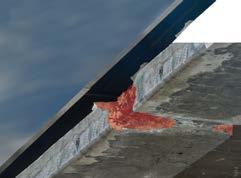
• Prevent unplanned expenses & manage risk
• Maximise warranty through automated tracking of repairs




• Gain full field-to-o ce visibility


DISCOVER MORE

Delta +25% since 2018 Corrosion Spall Delta +25% since 2015 Crack Delta +12% since 2017
WA Government finalises strategy to reconnect
Great Northern Highway through Fitzroy Crossing
Western Australian Transport Minister, Rita Saffioti, recently outlined the WA State Government's plan to reconnect the Great Northern Highway at Fitzroy Crossing.
Sections of the highway around Fitzroy Crossing were completely washed away in the recent one-in-100-year flood event, while the Fitzroy Crossing Bridge sustained significant damage and will need to be fully replaced.

The plan will involve the implementation of a barge system across the river, which will initially be operated by tugs, with a cable system to be operationalised shortly after. The barge system can be adapted when the river levels fall too low, using portable pontoons, which would act as a temporary crossing.
The barge system will be used while Main Roads constructs a low-level floodway crossing, which will provide a more permanent option while the full replacement of the Fitzroy Crossing Bridge is undertaken.
WA Main Roads is considering appropriate locations for the low-level floodway crossing, with construction expected to take around four months to complete. The Barge infrastructure could be reinstated if the river levels exceed the height of the low-level floodway crossing at any point.
WA Main Roads will work with industry to ensure transport operators are briefed on the operation of the barge system and is currently assessing options for breakdown areas for trucks on approach to Fitzroy Crossing.
Planning for a new bridge across the Fitzroy River is well underway. The new bridge will need to be higher and longer,
and will be dual-lane rather than the current single-lane bridge.
Main Roads commenced a fast-tracked procurement process during January to select a preferred contractor as soon as possible.
Meanwhile, heavy machinery and a 40-person strong road reconstruction crew continue to carry out repair works on the severely damaged section of the Great Northern Highway through Willare. The crews are working from both ends of a damaged 10-kilometre section of the highway and will be putting in place temporary gravel roads to allow for the reconnection between Broome, Derby and Fitzroy Crossing.
It's anticipated the works on the Willare section will take around four weeks to complete, with planning underway for a full road rebuild to begin in the dry season.
“This historic event has caused significant disruption on our road network, but I want to commend Main Roads and its partner agencies for working as quickly as possible as they look to put in place temporary solutions that allow for the reconnection of the road,” Minister Saffioti said.
“I also want to thank the community for their patience - we will work as fast as we can to implement these solutions but being in the middle of the wet season, there remains the possibility of significant rainfall events in the coming weeks and months which could disrupt works.”
“As we look to implement these solutions, we will work with the community and industry, particularly transport operators,
to make sure there is a good understanding of how the temporary barge option will operate,” she said.
“This will be the first time a barge system like this has been operated in this part of our State, so the final configuration and operation will depend largely on the conditions on the ground. Assessments of the existing bridge have been completed, and Main Roads has determined that given the significant damage, a full rebuild is the only feasible option.”
“Importantly, we will be looking to work closely with Traditional Owner groups on key cultural heritage issues, and to ensure that out of this emergency, we are creating employment and training opportunities for the local Indigenous communities Minister Saffioti added.
Speaking about the projects, Kimberley MLA Divina D'Anna, commented: “It is now clear there is a need for a new bridge. This will be a long-term project and I recognise the need for interim solutions in the meantime, that apply learnings from this flood event.”
“The combination of barges and the construction of a low level-crossing means we can adapt to the variable conditions we experience in the Kimberley across the year, including changes to the river level.”
“While this has been a devastating event for the Kimberley, there are opportunities for our community to benefit from the training and employment that will come with the rebuild effort, and I'll be advocating strongly to relevant Ministers within our government to make sure that happens, Ms D’Anna added.
10 Highway Engineering Australia | Feb/Mar 2023 INDUSTRY NEWS
DRYING DRUM MAINTENANCE
GET THE MOST FROM YOUR DRUM
Ammann’s after-sales team offers a maintenance plant that ensures your drum is operating properly – and productively.

Ammann Australia team will visit your plant, measure all turning parts and establish the required turning and grinding operations.
YOUR BENEFITS
• Maintain your drum’s full capacity
• Ensure energy efficiency
• Return your drum alignment to factory specification
• E xtend the life of your dryer drum, rollers, gear drive and bearings
• Prevent unplanned plant downtme
Nick Patterson Territory Manager Services
• Complete the service without interrupting production
• U tilise a low-cost solution compared to replacement
Ammann Australia Pty Ltd. 8/85 Pasturage Road, Caboolture, QLD 4510 For additional product information and services please visit : www.ammann.com Materials and specification data are subject to change without notice. PDM-2475-00-EN | © Ammann Group
+61 488 552 103 CALL US TODAY TO DISCUSS YOUR NEEDS
Mobile:
ONWARD UPWARD
Workzone Traffic Control continues to go from strength to strength, with two new business units and its recent expansion into the Northern Territory.

12 Highway Engineering Australia | Feb/Mar 2023 COVER
STORY
Established in 2004, Adelaide-based traffic management company Workzone Traffic Control certainly has come a long way over the past 19 years. From its earliest days with three staff and three vehicles providing traffic control services for SA Power Networks (a customer for which it still provides services), Workzone Traffic Control has continued to go from strength to strength, gaining an enviable reputation as a trusted and reliable service provider.
Not surprisingly, the company’s focus on safety, quality, innovation and sustainability has also seen it grow to become one of South Australia’s largest traffic control companies. With a fleet of over 75 specialist vehicles and over 30 Field Support and Office staff, together with a pool of more than 200 fully-trained and certified traffic controllers to meet the 24/7 demands of its clients, Workzone Traffic Control crews and vehicles are a common site right across South Australia – from metropolitan Adelaide to the most remote corners of the state.
“Back when we first started the company, the traffic management industry was still very much in its infancy,” said Managing Director Andrew White.
“Things were very basic in terms of both equipment and processes, and there was very little automation. Traffic management basically involved a ute, a whiteboard, traffic

controllers with stop/slow bats, paper-based traffic management plans, and not a lot else.”

“Thankfully, things really have changed a lot over the past 19 years – not only for us but also for the traffic management industry as a whole,” Andrew added, “and I’m proud to say that our focus on safety and innovation, has not only kept us relevant, it has also been a key driver in the success and growth of the business."
"Holding certifications for both Quality and Safety underpins our commitment to our clients and our staff.”
“While there are still customers out there that want a cheap job, Workzone aims every time to provide a compliant job which is also cost-competitive,” Andrew said. “Companies need to understand that cutting corners on safety these days will land them in hot water, especially given the updated industrial manslaughter and chain of responsibility laws.”
“Working in traffic is already dangerous,” he said, “and a compliant site, trained staff and approved signs and equipment are all essential safety pillars.”
As the business has grown, so too has its fleet of purpose-designed and built vehicles and equipment. Together with Workzone’s fleet of traffic control vehicles and sign trucks, the company also has the latest TMAs (Truck Mounted Attenuators) and LTMAs (Light Truck Mounted Attenuators) -
including a new hybrid unit – as well as a purpose-built cone deployment vehicle. The equipment fleet also includes the latest in high-tech radar speed displays, radar-equipped arrow boards and VMS (Variable Message Signs) units, remotecontrolled portable traffic lights and portable boom units.

From an operational perspective, Workzone’s entire booking, planning, and approvals process, as well as traffic management worker and asset scheduling, is all now managed centrally using a cloudbased software package.
"As well as streamlining all aspects of the traffic management process, the fact the planning system is integrated with both NearMaps and MetroMaps allows us to deliver an extremely high level of clarity in terms of both site planning and service delivery,” Andrew said.
“What’s more, the cloud-based nature of the system allows our field staff to access all of the data, including Traffic Guidance Schemes on mobile tablets out in the field. This, in turn, enables them to submit job safety analysis sheets, incident reports and time sheets, as well as any other ‘back-to-base’ communications direct from the job site - seamlessly and in real-time,” he added.
Importantly, despite the almost exponential growth of its traffic control operations, the team at Workzone are not ones to ‘rest on their laurels’, with the company recently expanding its operations to include two new divisions - Workzone Training and Workzone Safety & Signage –as well as a new traffic business (Workzone Territory) to service clients across the Northern Territory.
Feb/Mar 2023 | Highway Engineering Australia 13 COVER STORY
“Working in traffic is already dangerous, and a compliant site, trained staff and approved signs and equipment are all essential safety pillars.”
SIGNAGE: The centrepiece of all traffic management
Recognising that high-quality, visible and compliant signage lies at the heart of all traffic management, Workzone now also has its own in-house signage division.
Established in 2021, Workzone Safety and Signage provides a full suite of design and production services for signs and associated equipment. While it was initially set up to provide a reliable and timely source of high-quality, compliant signs for the company’s own traffic management operations, demand for its high-quality products has grown to the point where Workzone Safety & Signage is now the supplier of choice for an ever-increasing number of civil construction, telecommunications, utilities and maintenance companies across South Australia and beyond.
“Signage lies at the heart of all traffic management operations,” Andrew White said, “and the quality and visibility of signage is a critical factor in keeping everyone safe – including passing motorists, pedestrians, site workers and, of course, traffic management workers.”
“Establishing our own signage division was really a natural extension of our existing business, Andrew said. “After all, our team has been working with signs since we started in business.”
“So, when the opportunity presented itself, we purchased some state-of-the-art production equipment and software and set up the new sign production facility at our Hendon headquarters, and it’s taken off from there, really,” he added.
NOT ALL SIGNS ARE CREATED EQUAL
While to the untrained eye, it may be difficult to tell the difference between signs manufactured using different materials - especially in a ‘controlled’ indoor environment with good lighting - out on the road is quite a different matter. Signs not
only need to remain visible in all manner of ambient lighting conditions, they also need to be robust enough to withstand the harsh Australian environment (including extreme UV exposure) and tough roadside installation locations, where they are regularly exposed to inclement weather, dirt, road grime and debris from passing vehicles and equipment.

Workzone Safety & Signage, believes: “Even though all signs may look to be created equal, in reality, nothing could be further from the truth. Using inferior quality sign media, the wrong type of inks or inferior production techniques can not only result in signs that don’t last, it can also result in non-compliant signs that fail to meet the required retro reflectivity or on-road visibility requirements.”
“Needless to say, Inferior quality signs not only increase the risk of accidents and incidents, they inevitably end up costing more in the long run.”
“With that in mind, we only use certified 3M specialist road sign materials, the best in UV-stabilised high-performance inks, and the latest in high-tech production equipment and software which has been calibrated to the Australian Traffic Sign Standards. That way, we can be sure that we’re able to consistently produce highquality traffic control signage that’s fit for purpose and helps to maximise safety on site by meeting or exceeding the Standards EVERY time.”
In addition, Workzone Safety and Signage has access to a full range of suppliers for prismatic, transparent films and banner mesh.
FOCUS ON ECO-FRIENDLY SIGNAGE
Complimentary to its focus on quality, the team at Workzone Safety & Signage also focus on positive environmental outcomes, seeking out the latest in production methods, materials and technology.
“We use eco-friendly, water-based inks for printing, as well as biodegradable & recyclable products wherever possible, while at the same time, doing our utmost to support local South Australian suppliers and businesses.”

Even though the new division was only launched a little over 18 months ago, its focus on quality, consistency, compliance and attention to detail has seen a massive growth in demand for its signage products. In response, Workzone Safety & Signage has expanded both its production facility and its product offering to include a comprehensive range of safety products, signage, branding and commercial products across all industries and businesses, both in the public and private sectors.
For further information, please visit: https://www.workzonesigns.com.au/
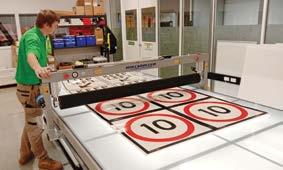
14 Highway Engineering Australia | Feb/Mar 2023 COVER STORY
WORKZONE TERRITORY:
Traffic Management in the Top End
Considering its extensive experience working in rural and remote areas across South Australia, Workzone Traffic Management’s expansion into the Northern Territory made sense as the next natural progression for the business.



Established in 2021 in the Darwin suburb of Winnellie, Workzone Territory provides a full range of traffic management services for councils, contractors and the DIPL (Department of Infrastructure Planning and Logistics), across the length and breadth of the Territory. As a standalone business with the Workzone group, Workzone Territory has the benefit of being able to provide clients with local knowledge and expertise, while also being supported by the extensive experience and resources of the other companies within the group. Simone Farrell, Manager of Workzone Territory, commented:
“When it comes to working in the Territory, local knowledge is critical.”
“As anyone who has ever been to the Territory will tell you, it is a unique and beautiful place, but it also has some of the most remote and unforgiving environments on the planet.”
“Setting up traffic guidance on a remote stretch of road hundreds of kilometres from the nearest big town is completely different to working on a suburban road
in a major city. The traffic mix is different, the environment is totally different, everything from the wildlife to the weather is different,” Simone said. “That’s why we place such an emphasis on local employment, especially within the remote indigenous communities.”
FOCUS ON INDIGENOUS EMPLOYMENT
“As well as providing valuable employment opportunities with genuine long-term career pathways, the wealth of local knowledge that exists within the communities - especially in terms of familiarity with the local environment and conditions - plays a key role in the way in which we develop and deliver services across the Territory,” Simone added.
Importantly, Workzone Territory’s focus on indigenous engagement – including providing employment and training opportunities in regional and remote communities - is a focus shared by the other companies with the Workzone group. In fact, First Nations peoples currently account for over 12% of the company’s permanent workforce, and this number is expected to continue growing as the company expands across South Australia and the Northern Territory.
For further information, please visit: https://workzoneterritory.com.au/
Workzone Territory’s commitment to engaging with indigenous communities is even reflected in its logo, which was designed by local WaraiLarrakia woman Martina Hazelbane.
Interestingly, designing the Workzone Territory logo was not Ms Hazelbane’s first involvement with the road safety/traffic management sector. In fact, far from it.
A winner of the national Trevor Christenson Law Award for Social Justice, Ms Hazelbane not only worked with Northern Territory local Clint Hoffmann on the award-winning digitised road rule book DriveAbout (which is available in no fewer than eight Indigenous languages), she also set up the Indigenous Road Safety Academy (IRSA) - a 100% Aboriginal-owned and led organisation set up with the aim of positively improving road safety in Indigenous Australia.
Feb/Mar 2023 | Highway Engineering Australia 15 COVER STORY
TRAINING : The critical pathway to safer traffic management
While most would recognise that traffic management operations carry a significant level of inherent risk, many would be surprised to realise how high that risk can be. Indeed, in the past four years alone, no fewer than 7 people have been killed on road work sites across Australia –and many more have been injured in near-misses.
Put simply, when it comes to traffic management, strict safety and operational procedures are of paramount importance, and failure to follow procedures can have disastrous consequences.
“Traffic management activities – as with any activities which bring people into close proximity to moving vehicles or equipment - carry an inherent level of risk,” Andrew White said.

“As anyone who has worked in traffic management, or for that matter, anyone who has ever been in a road work site, will tell you, it’s hard enough to get passing motorists to follow the signage and instructions and do the right thing. Having people on site who aren’t properly trained or don’t know what they’re doing only increases the risk of an accident, injury or fatality.”
“While there is currently a process underway to harmonise traffic management procedures, including training and certification requirements, across Australia, we still have a situation where the quality of training, as well as the knowledge and capability required to achieve certification, can deviate widely from location to location,”

he said. “In fact, there are still some instances where all that’s required to call yourself a qualified traffic management worker, is to complete a two-day course for $400.”
“Considering that traffic management workers are responsible for the safety of workers on the site, passing motorists and pedestrians and, of course, themselves and their fellow traffic management workers, we believe that this ‘tick and flick’ approach to training is just not good enough,” Andrew added.
COMPREHENSIVE TRAINING COURSES
With that in mind, Workzone Training has committed to delivering a range of comprehensive training courses, conducted by qualified instructors and assessors. The courses, which combine face-to-face ‘classroom-based’ learning with practical training in a controlled environment, are conducted at a dedicated training facility, located within the company’s Hendon headquarters.
16 Highway Engineering Australia | Feb/Mar 2023 COVER STORY
Held over 2 days and involving up to 17 hours of study time, Workzone Training’s ‘Work Zone Traffic Management Course’ incorporates the nationally-recognized RIIWHS205E - Control traffic with stopslow bat (Release 2) and RIIWHS302E - Implement traffic management plans (Release 1) units of competency, together with additional learnings relating to tools and equipment, signs and other traffic control devices, controlling site construction vehicles and working with a pilot vehicle in a shuttle flow work arrangement.
Upon successful completion of the course, students are provided with a Statement of Attainment for both units of study, as well as a South Australian Department for Infrastructure and Transport (DIT)-issued Workzone Traffic Management card.
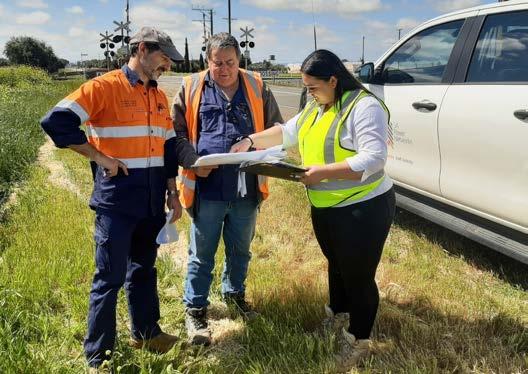
REFRESHER AND JOB TICKET COURSES
In South Australia, the Department for Infrastructure and Transport (DIT) governs the safe undertaking of work zone traffic management. In order to ensure that traffic management personnel stay upto-date and are familiar with the latest procedures, rules and equipment, all traffic management personnel are required to undertake a three-yearly refresher course to maintain current accreditation.

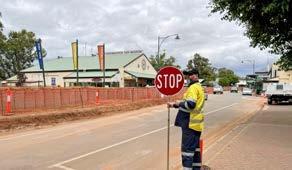
To that end, Workzone Training delivers a 1 day faceto-face ‘Work Zone Traffic Management Refresher Course’ covering all aspects of the job, ranging from planning and preparing for work, controlling traffic, and operating communication devices,
through to setting out and monitoring traffic guidance schemes, conducting close down work activities, and conducting housekeeping activities. Upon successful completion of the course, attendees are provided with a Statement of Attainment and an updated Work Zone Traffic Management licence.
Workzone Training also conducts a number of ‘job ticket’ courses, including fully-accredited construction site WHITE CARD training, which provides students with the basic knowledge required to work on construction sites, including applicable legislation, hazards that they are likely to encounter, and risk control techniques. Under national WHS legislation, all workers on construction sites are required to have successfully completed White Card training (Unit of Competency: CPCWHS1001Prepare to Work Safely in the Construction Industry) prior to commencing work on site.
WORKZONE TRAINING IN THE TERRITORY
RIIWHS205E - Control traffic with stop-slow bat (Release 2); RIIWHS302E - Implement traffic management plans (Release 1); and RIICWD503E – Prepare Traffic Management Plans and Traffic Guidance Schemes.
This capability was enabled following the successful acquisition of ETAS Training after a long collaboration with ETAS owner Brian Kakoschke, a highly respected trainer in the top-end.
In addition, Workzone Training is now also offering accredited training courses for Forklift Operation and elevated work platforms (TLILIC0003 - Licence to operate a forklift truck and RIIHAN301E - Operate elevating work platform).
Workzone Training will also be aiming to add a range of industry-specific content over the next two years as it works towards the adoption of the nationally harmonised training model, courses in safe cone truck operation, TMA/LTMA Qualifications, safe night work and remote traffic operations.
For further information, please visit: https://www.workzonetraining.net.au/
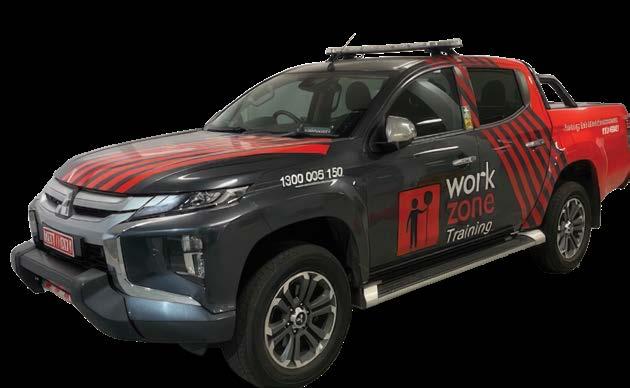
Feb/Mar 2023 | Highway Engineering Australia 17 COVER STORY
FOCUS
VERSATILE 6” PUMP
Big self-priming pumps seem to be coming into their own for mining, quarry, construction and even infrastructure applications. Australian Pump Industries have developed a line of high-flow pumps that are equally at home in quarries or sewage stations.
The company offers two models of 6” pumps. Both are designed for handling solid-laden liquids and are delivered in complete ‘trash’ handling configuration. The biggest, powered by an 80 hp Deutz air-cooled diesel engine, offers flows up to 6,000 lpm. That’s 360,000 litres per hour!
This big machine is the choice of Local Government bodies wanting to provide true flood emergency response, and normally specify the units as you would for a construction site - as a trailer-mounted version.
What makes the trash pump concept so popular for dewatering applications is their ability to handle solids in suspension. Aussie’s model MQ600TD pump is capable of passing 76mm solids in suspension.
An important part of that design concept, was building the pump in a heavy duty selfpriming body with a front clean out port that allows the operator to open the pump up for clean out in a matter of one or two minutes.
A smaller, more compact model - the Aussie QP60TD - is powered by a Kubota water cooled 24.8hp diesel engine. It has maximum flows of 4,000 lpm and a maximum head of 35 metres. Priming is through a direct vertical lift of seven metres. Like it’s big brother, the MQ600TD, it also has a front opening port that enables ‘chokes’ to be cleared easily!
The impeller in both pumps is a big ‘non-clog style’ open design that facilitates the pumping
of contaminated water, whether it be silty material from a flood or, effluent or sewage waste from a bypass system.
WHY WET PRIME?
The reason Aussie has focused on wet prime pumps is because of the negative aspects of the ‘dry prime’ concept. Dry prime pumps are normally end suction design that require the use of priming devices to be able to lift water as part of the prime process.

Those devices can be anything as rudimentary as a hand pump to sophisticated vacuum pumps or even compressors.
The limitation of those priming aids is that they are not designed to handle dirty water, whether it’s effluent or construction site waste products.
HOW DO THEY PRIME?
The beauty of Aussie’s wet prime pumps is the priming system itself. The pumps are designed with huge ‘shoulders’ that are cast into the pump’s body. The shoulders constitute a water tank that holds enough water to enable the pump to prime efficiently.
The priming process is simple. There is a priming plug built into the top of the casing of the pump. The operator fills the pump with water which is trapped inside the pump housing by a check valve fitted to the suction port.
The operator ensures the suction hose has no air leaks, always a good move to check the couplings, and then starts the engine.
The pump voids through the discharge water that is in the body, creating a vacuum. The check valve then opens on the suction port, drawing up water through the 6” suction line.
This simple priming process avoids a lot of service issues.
Normally, priming a pump like this takes only minutes and specifically doesn’t require the suction hose to have a foot valve. Australian Pump recommends a strainer should be on the end of that hose as foot valves are unnecessary and can clog up with solids entering the valve.
The two big pumps have engine protection equipment built in. The air-cooled Deutz diesel comes with low oil pressure, oil temperature and V-belt failure shutdown. The Kubota watercooled diesel with the smaller pump has low oil pressure and oil temperature shutdown incorporated.
In both cases, oil-lubricated mechanical seals are fitted, with the bigger MQ600TD pump having a tungsten titanium carbide seal as standard.
BUILT-IN VERSATILITY
Although these pumps were originally designed for mine and construction site dewatering, their ability to provide flood mitigation services or effluent bypass is well established. They have also been applied to aeration duties on effluent or sewage wastewater lagoons, providing trouble-free and reliable service.
Both pumps offer fuel tanks with sufficient capacity to run for up to ten hours at a time without refuelling. Australian Pump also offers free extended warranties on this equipment, with pumps having up to five years guarantee. The engines - both Kubota and Deutz - come with two-year manufacturers’ warranties.
For further information on these multifunction assets, contact Australian Pump Industries (Aussie Pumps) on 02 8865 3500 or visit: www.aussiepumps.com.au
C M Y CM MY CY CMY K
18 Highway Engineering Australia | Feb/Mar 2023 PRODUCT
STOCKRANGE OF MODELS NOW SET UP & READY TO GO
At A1 Roadlines we understand that our customers have a range of preferences when it comes to fleet vehicles. That’s why we fit and service the Scorpion II TMA across a full range of suitable host vehicles from world-leading manufacturers including ISUZU, UD, FUSO and HINO to name a few.


So, when it comes to selecting a fully MASH tested, passed and eligible TMA that has also been ASSESSED, APPROVED & RECOMMENDED FOR ACCEPTANCE throughout Australia by ASBAP (Austroads Safety Barrier Assessment Panel), the only name you need to remember is Scorpion II® TMA from A1 Roadlines. When it comes to the brand of host vehicle… that’s up to you!




THE EQUIPMENT YOU NEED – THE SERVICE YOU EXPECT A1 Roadlines Pty Ltd | 89 Rushdale Street, Knoxfield, Victoria 3180 | www.a1roadlines.com.au P: 1300 217 623 (A1ROAD) | F: (03) 9765 9499 | E: sales@a1roadlines.com.au THE CHOICE IS YOURS!
IN
INFINITY TESTING
'Infinity

NO RELIANCE ON ROLL-AHEAD DURING AN IMPACT
Rather than relying on some of the impact energy being absorbed by the forward movement of host vehicle on which the TMA is fitted, with ‘Infinity Testing’ the host vehicle is anchored to the ground to prevent any forward movement during an impact.

‘WORST CASE’ SCENARIO TESTING
Compared to standard testing with an unrestrained host vehicle, Infinity Testing is a much tougher testing regimen. It is considered ‘worst-case scenario’ testing which makes it much more difficult to meet the pass criteria for IS values, as all of the Ridedown Acceleration must be provided by the TMA absorbing the energy from the impact.
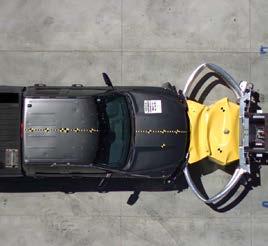


TMA ABSORBS & DISSIPATES 100% OF THE IMPACT ENERGY
Testing the TMA on a host vehicle which is anchored in place, tests – and for both the Scorpion II® TL-3 and Scorpion® II METRO® TL-2 TMAs – confirms the capacity of the TMA to absorb/dissipate 100% of the impact energywithout the benefit of the host vehicle roll-ahead.

NO UPPER LIMIT FOR HOST VEHICLES
From a practical standpoint, the fact that both the Scorpion II® TL-3 and Scorpion® II METRO® TL-2 TMAs were successfully tested to MASH Standards using the ‘Infinity Testing’ method, means both units are MASH certified with no upper weight limit for the host vehicle.


www.a1roadlines.com.au
Testing’ is without a doubt the harshest method of testing the performance of a Truck Mounted Attenuator (TMA) during an impact.
THE ULTIMATE TEST OF ATTENUATOR PERFORMANCE

HOW IT’S DONE
With ‘Infinity Testing’ the host vehicle is anchored in place during the impacts to assess the TMA's capacity to absorb/ dissipate 100% of the impact energy without the benefit of roll-ahead.



WHAT ABOUT ROLL-AHEAD DISTANCES?
Importantly, to emulate ‘real world’ operating conditions, both the Scorpion II® TL-3 and Scorpion® II METRO® TL-2 TMA have also been successfully tested and MASH certified using standard ‘non-anchored’ host vehicles, with both units posting impressively low roll-ahead distances.
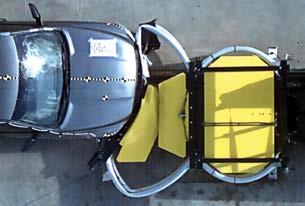
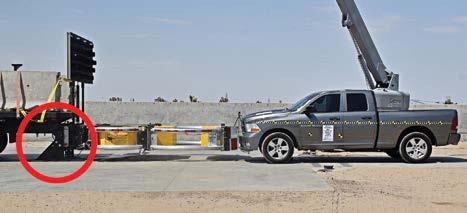
THE EQUIPMENT YOU NEED – THE SERVICE YOU EXPECT A1 Roadlines Pty Ltd | 89 Rushdale Street, Knoxfield, Victoria 3180 P: 1300 217 623 (A1ROAD) | E: sales@a1roadlines.com.au
Scorpion® II TL-3 TMA Crash Test: MASH Test 2-53 Impacting Vehicle Weight: 2266kg Impact Angle: 10.3 Degrees Impact Speed: 103.8km/h Roll-Ahead Distance: 5.1m Scorpion® II METRO® TL-2 TMA Crash Test: MASH Test 2-53 Impacting Vehicle Weight: 2295kg Impact Angle: 9.9 Degrees Impact Speed: 81.6km/h Roll-Ahead Distance: 12.4m
QUEENSLAND TO EXPAND SPEED ENFORCEMENT WITH TRANSPORTABLE CAMERA ROLLOUT
Queensland Government is set to expand speed enforcement across the state using transportable cameras in an effort to cut the road toll.
Road safety technology specialist Acusensus has been appointed to oversee a state-wide rollout of its trailer-based transportable speed camera enforcement solution, to be located in regional and remote areas, as well as metropolitan cities. Acusensus, which operates Queensland’s successful mobile phone and seat belt camera program, is expected to roll out the five-year trailer-based speed enforcement program this year.
The announcement of this $11.7 million contract over an initial five-year term comes on the back of the Queensland government’s decision to host a road safety roundtable last month after the state recorded 299 fatalities last year, its highest in 10 years.
Acusensus, uses patented AI camera technology that can detect drivers using their mobile phones, seatbelt non-compliance, speeding, vehicles driving in closed freeway lanes, unregistered vehicles, and vehicles of interest. The fixed and mobile cameras can operate at night and in all weather conditions, generating high-quality images as evidence
for enforcement and prosecution purposes to deter dangerous driver behaviours.
In addition to Queensland, the company also has multi-year government contracts in NSW, WA and the ACT and has operated programs on five continents.
Acusensus founder and Managing Director Alexander Jannink said the decision to use trailer-mounted mobile speed cameras would help to improve driver behaviour across the state.

“Queensland was the first jurisdiction in the world to roll out simultaneous mobile phone and seat belt compliance enforcement, and it is now the first to partner with industry to deliver a completely trailer-based mobile speed camera enforcement program, underlining the state’s commitment to improving road safety across the network and being proactive in reducing road trauma,” Mr Jannink said.
“Speeding remains one of the largest sources of road trauma. Enforcement programs are effective in improving driver behaviours and have been proven to work to reduce deaths and injuries over the longer term,” he said.
“Having the ability to easily transport our speed detection trailers enables us to reach
more remote locations and focus on regions that typically experience a high incidence of road casualties. Drivers need to be aware that they can be caught anywhere and at any time and should adjust their behaviours and habits to drive safely in all conditions."
"It will not only save their lives, but also the lives of their loved ones and other innocent parties,” Mr Jannink concluded.
ABOUT ACUSENSUS
Acusensus is a technology company that was founded in 2018 with a mission to design and develop artificial intelligence-enabled road safety solutions. Collaborating with governments and commercial stakeholders to tackle distracted driving globally is Acusensus’ first priority.
Acusensus has pioneered intelligent solutions that provide anywhere, anytime digital evidence that can be used in conjunction with law enforcement to drive behavioural change and improve road safety. Acusensus technology is used to detect and provide prosecutable evidence of distracted driving (mobile phone use), seatbelt compliance, speeding, railway crossing compliance and the monitoring of vehicles of interest.
For more information regarding Acusensus solutions, visit: https://www.acusensus.com/
22 Highway Engineering Australia | Feb/Mar 2023 ROAD SAFETY
REPORT REVEALS SCALE OF NATIONAL ROAD SAFETY CHALLENGE
Analysis undertaken by Australia’s peak motoring body shows national road deaths heading in the wrong direction, and dramatic change is required if recently agreed targets are to be met or even measured.
The AAA’s first report tracking the performance of the NATIONAL ROAD SAFETY STRATEGY 2021-2030 shows that while road deaths decreased by 0.7 per cent from the September 2022 quarter to the December 2022 quarter, road deaths increased by 5.1 per cent throughout the whole of 2022: a year in which 1,187 people died on Australian roads.
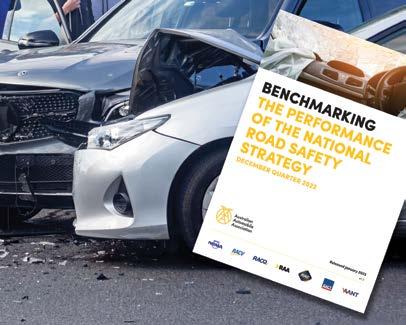
These significant increases are occurring within the context of a National Road Safety Strategy agreed upon by all Australian governments in December 2021, which targets a 50 per cent national road death reduction by 2030.
The report shows that among the states and territories, Tasmania (42.9 per cent), the NT (34.3 per cent), the ACT (63.6 per cent) and Queensland (7.9 per cent) saw the largest increases in road death numbers. It also shows three of the Strategy’s five 2030 targets are either undefined or unable to be measured. These are: “serious injuries reduced by 30 per cent”; “zero deaths in city CBD areas”; and “zero deaths on all national highways and on high-speed roads covering 80 per cent of travel across the network”.
AAA Managing Director Michael Bradley said: “This is yet another report that shows our national approach to road trauma management continues to lack clarity and coordination.
“The strong targets agreed by governments are welcome, but strong targets do not by themselves deliver better results. If we want different outcomes, we need to change the way road trauma is being managed and the first step must be appropriate reporting and sharing of road crash information.
“It is unacceptable that governments continue to commit to reducing trauma metrics that they do not measure or report.
“Until road trauma data is openly reported and used by governments, the most significant causes of Australian road trauma; the most appropriate interventions; and the effectiveness of the plans currently in place, will remain unknown.”
The Australian Automobile Association is the nation’s peak motoring body, representing Australia’s state-based motoring clubs and their 8.9 million members. The AAA is an apolitical and technology-neutral advocate for federal transport policy that improves safety, affordability, and mobility.
Read the full report at: https://www.aaa.asn.au/wp-content/ uploads/2023/02/230130_AAA_Benchmarking-NRSS-Report-DecQTR-2022-Web-1.1.pdf
DRIVING-STYLE DATA COULD HELP PREVENT CRASHES

Using data on driving styles collected by vehicles could be used to help understand where crashes on the road network are likely to take place before they actually happen. This would lead to pre-emptive road safety interventions rather than those that follow as a reaction to collisions and personal injury.
The suggestion is one element of a report published recently by a group of senior transport professionals in the UK who received funding from the Rees Jeffreys Road Fund. Amongst the authors is the director of the RAC Foundation, Steve Gooding.
In the study, Key questions for road investment and spending, published by the University of the West of England, the researchers suggest that much more attention be should be given to ‘lead’ rather than ‘lag’ indicators across all roads; for example, using increasingly available data sources (such as vehicle speeds and harshness of braking) to identify where and why safety risks are likely to arise and inform decisions on appropriate risk mitigations, while relying less on historic data (for example about individual crash locations).
The report points out that in 2021, 1,558 people were killed on Britain’s roads, which “…raises questions over whether and how further improvements in road safety can be achieved, and to what extent spending on the roads themselves should be part of the solution.”
The report found that in 2021 road casualties showed signs of a return to pre-pandemic trends as traffic levels grew back. However, while the overall figures for 2021 were lower than pre-pandemic levels, it found that over the second half of the year, casualties returned to levels similar to those in 2019.
The report also suggests that consideration be given to involving local authorities in speed management:
“While the prospect of enabling highway authorities to pursue moving traffic offences such as speeding could potentially reduce the historic reliance on enforcement through road policing and thus make speed management and the associated enforcement a more viable and costeffective tool, it would require the building of an appropriate skillset and a budget for running costs.”
More broadly, the group of experts – the Road Investment Scrutiny Panel – identified a range of key measures necessary to get the best out of road investment, including:
• road spending decisions need to be coherent and stand up to scrutiny when viewed in the context of broader policy aims, most notably the statutory duty to achieve a net zero carbon economy;
• decisions should be well-informed both in relation to the existing road network and its use (including ‘connected’ vehicles generating data on driver behaviour such as patterns of harsh braking that could allow identification of locations posing road safety risks) and in terms of future possibilities in a changing and uncertain world;
• the need for more transparency regarding how decisions were arrived at and the underlying analysis.
Feb/Mar 2023 | Highway Engineering Australia 23 ROAD SAFETY
NHTSA RELEASES NEW STUDY EXAMINING THE COST OF MOTOR VEHICLE CRASHES, INJURIES AND FATALITIES ACROSS THE USA
According the a new report released by the US National Highway Traffic Safety Administration (NHTSA) in January, motor vehicle crashes cost American society a staggering US$340 billion in 2019 alone. The agency’s new report, “The Economic and Societal Impact of Motor Vehicle Crashes, 2019” examines the costs of one year of crashes that killed an estimated 36,500 people, injured 4.5 million, and damaged 23 million vehicles.
“This report drives home just how devastating traffic crashes are for families and the economic burden they place on society,” said Ann Carlson, NHTSA’s Acting Administrator.
“We need to use the safe system approach embraced in DOT’s National Roadway Safety Strategy to dramatically decrease the number and severity of crashes: safer roads, safer people, safer vehicles, safer speeds, and better post-crash care.”
The report draws on data from a range of crashes, including ones that lead to property damage, serious injuries and fatalities. Data sources include NHTSA’s Fatality Analysis Reporting System, Crash Investigation Sampling System and the Crash Report Sampling System. The report also examines crashes not reported to the police, using consumer survey data, in-car observation techniques and a variety of other sources.
The $340 billion cost of motor vehicle crashes represents the equivalent of $1,035 for each of the 328 million people in the United States and 1.6% of the $21.4 trillion real U.S. gross domestic product for 2019.
Those not directly involved in crashes pay for roughly three-quarters of all crash costs, primarily through insurance premiums, taxes, congestion-related costs such as lost time, excess fuel consumption, and increased environmental impacts.
Traffic crashes cost taxpayers $30 billion in 2019, roughly 9% of all motor vehicle crash costs. This is the equivalent of $230 in added taxes for every household in the United States.
These losses include medical costs, lost productivity, legal and court costs, emergency service costs, insurance administration costs, congestion costs, property damage, and workplace losses. These figures include both police-reported and unreported crashes.
When quality-of-life valuations are considered, the total value of societal harm from motor vehicle crashes in 2019 was nearly $1.4 trillion.

The report includes new data on the total value of seat belt use. From 1975 to 2019, seat belt use saved 404,000 lives and prevented $17.8 trillion in societal harm.
The report also looks at the cost of risky driving behaviours that contributed to crashes that led to fatalities, serious injuries and property damage only, including:
• Alcohol - Alcohol-involved crashes resulted in 14,219 fatalities, 497,000 injuries, and $68.9 billion in economic costs in 2019, accounting for 20% of all crash costs. Crashes involving alcohol levels of .08 BAC or higher are responsible for more than 90% of the economic costs and societal harm from crashes attributable to alcohol use.
• Distraction - Crashes where at least one driver was identified as being distracted resulted in 10,546 fatalities, 1.3 million nonfatal injuries, and $98.2 billion in economic costs in 2019, accounting for about 29% of all crash costs.
• Failure to Wear a Seat Belt - Failure to buckle up caused 2,400 avoidable fatalities, 46,000 serious injuries, and cost society $11 billion in easily preventable injuryrelated costs, accounting for about 3% of all crash costs. Seat belts work. Seat belt use prevented more than 14,600 fatalities, 450,000 serious injuries, and $93 billion in injury-related economic costs in 2019.
• Speeding - Speed-related crashes are associated with 10,192 fatalities, 498,000 nonfatal injuries, and $46 billion in economic costs in 2019, accounting for 14% of all economic costs. Speed-related crashes cost an average of $141 for every person in the United States.
The report also includes data on the costs associated with motorcycle crashes, failure to wear motorcycle helmets, pedestrian crashes, bicyclist crashes, and numerous different roadway designation crashes.
Roadway fatalities and the fatality rate across the USA declined consistently for 30 years, but progress has stalled over the last decade and went in the wrong direction in 2020 and 2021. The USDOT’s National Roadway Safety Strategy outlines what the Department is doing to address this crisis.
24 Highway Engineering Australia | Feb/Mar 2023 ROAD SAFETY
BIG (SAFE) CARDBOARD CAR HELPS TO EDUCATE YOUNG VICTORIANS ABOUT VEHICLE SAFETY TECHNOLOGIES

During January, a life-size cardboard car was parked at the Melbourne Museum’s Galleria in an effort to educate young Victorians and their parents or carers on the importance of vehicle safety technologies. The Big (Safe) Cardboard Car exhibit helped to educate visitors to the Museum on the critical role of a variety of vehicle safety features, proven to save lives on Victorian roads.
One such safety feature is Auto Emergency Braking (AEB), which is estimated to reduce death and serious injury from rear-end crashes by 27 per cent. AEB is designed to detect objects in a vehicle’s path and brake automatically when the driver can’t – helping lessen the impact of a crash and, in some circumstances, prevent the crash entirely.
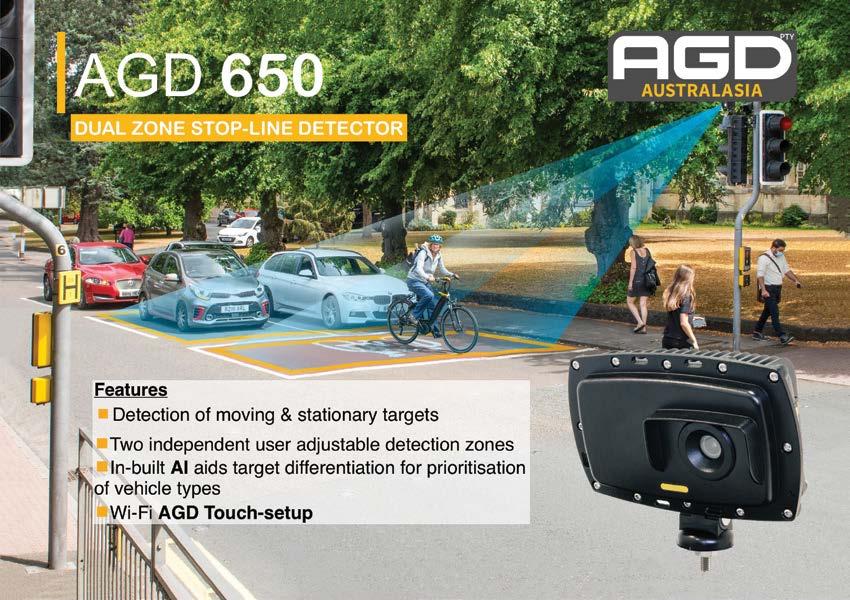
Other safety features people were able to learn about included Lane Keep Assist (LKA), Intelligent Speed Assist (ISA), reversing cameras, and blind spot warning systems.
Visitors taking part in the Museum’s schoolholiday program were encouraged to inspect the Big (Safe) Cardboard Car, watch the time-
lapse 'making of' clip on the big screen and participate in hands-on activities to understand the value of vehicle safety.
The exhibit also promotes the Transport Accident Commission’s How Safe Is Your Car website, inviting adult visitors to guess the safety rating of their current vehicle – which they could then check on the website.
“Not all cars are created equal, and some cars are safer than others,” said TAC Acting CEO, Liz Cairns. “We encourage people to investigate and buy the safest vehicle in their price range. Everyone can and should visit howsafeisyourcar.com.au to compare vehicles.”
The Big (Safe) Cardboard Car exhibit formed the centrepiece of the family-friendly program designed by Australian cardboard architect and Founder of Fold Theory, Tobias Horrocks.
Speaking about the exhibit, Tobias Horrocks, commented: “I love how it turned out, and the fact that it encourages people to think about what they can do to make our roads safer for everyone makes it even more rewarding.”
Removing unsafe vehicles from the road and promoting vehicle safety technologies is a priority of the Victorian Government’s Road Safety Strategy, which aims to halve road deaths and reduce serious injuries by 2030.
While at the museum, visitors can also discover the science behind crashes and take a trip into the future of travel at the Road to Zero Experience Space, located on the lower ground floor of the Melbourne Museum. The Road to Zero complex, was established in 2018 as part of the Victorian State Government’s $146-million Young Driver Safety Package and developed by the TAC in partnership with Museums Victoria.
Victorian Minister for Roads and Road Safety, Melissa Horne, commented: “By encouraging young Victorians to embrace road safety at an early age, we know we can make a real difference in continuing to drive down the road toll in the years ahead.”
admin@agd-systems.com.au - www.agd-systems.com.au
Victorian Minister for Roads and Road Safety, Melissa Horne visiting the Big (Safe) Cardboard Car exhibit at the Melbourne Museum.
The DOLRE bridge tra c barrier development demonstrates how the incorporation of FEA into the design process can optimise a solution that is vastly di erent from the solutions that traditional Engineering methodologies would produce.
A problem was identified and through the iterative use of FEM combined with Eurocodes for structural analysis a solution was found and optimised that was vastly di erent to the direction that traditional engineering was leading.
Once the bridge barrier design was optimised, the same process was used to assess transition designs to various European roadside barriers in accordance with EN1317 and TR16303-2011 requirements.
Australian authorities required product assessment to Australian bridge standards. Future finite element modelling in accordance with MASH standards and NCHRP179 validation requirements satisfied ASBAP’s analysis for both tra c barrier and transition designs.










 Transition Test #1 for 2270kg Ute
Transition Test #2 for 2270kg Ute
Transition Test #3 for 2270kg Ute
Transition Test #1 for 900kg Sedan
Transition Test #1 for 13,000kg Bus
Transition Test #1 for 2270kg Ute
Transition Test #2 for 2270kg Ute
Transition Test #3 for 2270kg Ute
Transition Test #1 for 900kg Sedan
Transition Test #1 for 13,000kg Bus



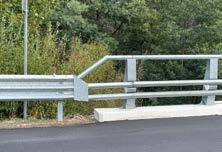

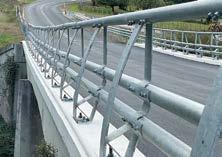

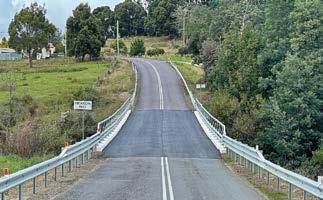








www.lbaustralia.com.au Ph 1300 522 878 • Fully crash tested to European Standards and simulated to US MASH TL4 requirements • Unique design imparting low stress to bridge deck - protecting water proofing membranes and coatings on the deck • Easy to install • Easy to dismantle in times of flood • Cost-e ective bridge rehabilitation solution Ideal for Bridge Refurbishment Projects. ASBAP Approved for use in Australia DISCOVER MORE
AUSTRALIA SET TO PASS 100K EV MILESTONE
New research by the Electric Vehicle Council has revealed Australia is on track to soon pass the milestone of 100,000 electric vehicles, with more than 83,000 EVs estimated to be on our roads now. The new research, contained in the Australian Electric Vehicle Industry Recap 2022, also finds that of the 83,000, 79 per cent are battery electric vehicles (BEVs) versus 21 per cent plug-in hybrids (PHEVs). Only 44,000 EVs were in circulation at the beginning of 2022.
The new report also notes that the number of EVs purchased increased by 86 per cent in the last year, with 3.8 per of all new cars purchased being electric. However, Electric Vehicle Council Chief Executive Behyad Jafari warned there was no room for complacency.
“If you think you're seeing more EVs on the road than you used to, you're right, but if we want to hit our national emissions targets, we won't make it on this current trajectory,” Mr Jafari said.
“To achieve the federal government's emission target, we'll need a near fully zeroemission vehicle fleet by 2050. To stay on track, that means reaching 1 million EVs by 2027 and around 3 million by 2030.”
“We can definitely hit these goals, but not without an ambitious fuel efficiency standard to expand the supply of EVs to Australia. The federal government should introduce this standard this year as a matter of urgency,” Mr Jafari said.
“Australians are early adaptors by nature, we care about our environment, and we don't want to rely on foreign oil. There is no reason for us to continue to lag the world on EV take up,” he added. “The enthusiasm is there in abundance, we just need our governments to continue the policy reform that makes it easy to transition away from the exhaust pipe.”
The new report also notes that the number of public chargers has increased from 3,413 in 2021 to 4,943 in 2022. Fast chargers are up from 231 to 365.
SEA ELECTRIC PARTNERS WITH MEVCO TO ELECTRIFY 8,500 HILUX AND LANDCRUISER MODELS FOR MINING INDUSTRY

SEA Electric has made the next step in its journey to electrify the world’s commercial vehicle fleet, by signing a significant Memorandum of Understanding with MEVCO, a leading systems integrator focused exclusively on electric light commercial vehicles within the mining industry. The partnership will see specialist all-electric Hilux and Landcruiser models made available for the mining industry, with MEVCO making a commitment to order 8,500 units over the next five years. The deal has a total value of close to AU$1 billion.
At the time of the launch, over half of the 2023 allocation of the Australian-developed battery-electric vehicles have been pre-sold, with demonstration models available in Melbourne, Brisbane and Perth.
At the heart of the arrangement is SEA Electric’s proprietary SEA-Drive® power-system, which provides leading allelectric range, driving performance, and environmental credentials, with zero local emissions of carbon dioxide, methane, or nitrous oxide. Thanks to its medium-voltage architecture and no requirement for active thermal management, SEA Electric’s solution is light, cost-effective, and efficient, with the system tested in the field across eight countries with over 2.5 million kilometres of real-world use registered to date.
Available in various mining-specific designs for 4×4 and 4×2 configurations, the vehicles can be specified with two SEA-Drive®
options, namely an 88kWh battery which provides 380km of range, or a 60kWh battery delivering up to 260km of use.

Fast DC to DC charging is available for the system, which provides up to 80 per cent battery power in less than one hour, with a five-year factory warranty on the batteries supplied.
For users, the switch to EV provides a comfortable work environment, with health and safety considerations including no noise, fumes, heat, or vibrations.
MEVCO is a portfolio company of RCF Jolimont – the innovation fund of Resource Capital Funds, one of the largest private equity managers in the world focused on mining.
“This is a pivotal partnership for the mining industry,” said Matt Cahir, MEVCO CEO.
“It enables the world’s leading EV technology for heavy and light commercial trucks to be commercialized on a scale that makes sense for the bespoke needs of the mining sector.
“SEA Electric’s unique architecture is perfectly suited for the task, with the system’s high-torque characteristics ideally fit for purpose.”
For SEA Electric, the announcement is the logical next step in the company’s expansion in the commercial vehicle space, opening up possibilities for the technology on a global scale for a wide variety of applications.
“Across all industries, companies now understand they have a role to play in ensuring they are a part of the solution to the environmental problems we face,” said Tony Fairweather, SEA Electric Founder & CEO.
“With the SEA-Drive® power-system, we have developed technology that is perfectly adaptable to a wide range of commercial vehicle tasks that have typically been the domain of diesel-powered engines.
“Through MEVCO, the mining industry will now be able to access cutting-edge technology, which delivers top performance and total cost of ownership prospects, all with sustainability at the forefront.
“This deal is a significant step forward in Australia and shows just what is possible when it comes to electrifying the world’s fleets.”
For more information you can visit: www.sea-electric.com/en_au and www.mevco.com
28 Highway Engineering Australia | Feb/Mar 2023 ELECTRIC VEHICLES
Caravan Industry Association of Australia believes the answer to future regional connectivity is through the caravanning industry, with calls for support on transforming its national caravan park network into a fast charge super network.

Scenes witnessed over the summer holidays in many holiday towns around the country, with lengthy queues and hours-long wait at the local community EV charger, are a sign of things to come. As we look towards a future with more EVs on the road, our holiday travel and road trips could look very different if we don’t start to act now.
Growing frustrations and the real threat of limited charger opportunities could significantly stifle the caravanning industry, the backbone of domestic tourism, and an industry that contributes over $27 billion per annum to Australia’s economy.

in some of Australia’s key regional destinations and overnight transit routes we believe we can be at the forefront of the transition.” said Stuart Lamont, CEO of Caravan Industry Association of Australia.


“We are looking to government to support a market readiness report to articulate and demonstrate the architecture and road map for an open market response to a fast charger network provision. We know technology also exists that parks can utilise to not only be a charger location but be a community energy collector and contributor.”



“Early conversations have been promising in terms of the technology options for a network, and we know possibilities to be a major contributor are endless. Unfortunately, these options require significant financial contribution and a will to be solution focused,” Mr Lamont added.

CAN CARAVAN PARKS BE THE ANSWER TO EV CHARGING INFRASTRUCTURE? THE WAIT IS OVER The New Era of Electric is Here Compact Urban Sweeper S2 Garwood International’s 100% Electric Compact Sweeper AVAILABLE EXCLUSIVELY FROM: Tony Miller 0429 444 451 tony@garwoodinternational.com.au VIC, TAS & SA Ian Pinney 0409 905 451 ian@garwoodinternational.com.au reece@garwoodinternational.com.au daniel@garwoodinternational.com.au Call us today to organise a demo. Feb/Mar 2023 | Highway Engineering Australia 29 ELECTRIC VEHICLES
CHANNEL TUNNEL REACHES A TECHNOLOGICAL GRID MILESTONE
In February, the Channel Tunnel, the longest undersea tunnel in the world, reached a technological milestone with Getlink’s commissioning of a high-voltage grid solution from GE Renewable Energy’s Grid Solutions business. GE’s flexible Static Synchronous Compensator (STATCOM¹) solution delivers the fast voltage support Eurotunnel requires to be able to run up to 16 trains simultaneously in the Channel Tunnel - a 60% increase in maximum capacity or as many as 1,000 trains per day.
The busiest and most heavily used rolling motorway in the world, Eurotunnel decided to increase the power and stability of its network to ensure a constant flow of traffic and meet peak demand when multiple trains run simultaneously. The STATCOM solution, developed by GE and adapted to the Channel Tunnel in collaboration with Eurostar, supports voltage stability, grid resilience, and enhanced power transfer capability.
The STATCOM solution will double the reactive compensation power flow as well as improve stability even during peak periods and deliver enhanced quality of service by enabling optimized regularity of the freight and passenger shuttle service.
“Faithful to its pioneering spirit, the Channel Tunnel welcomes the world's largest and most powerful STATCOM solution in a railway environment. This state-of-the-art technological system reinforces the reliability and capacity of our infrastructure and ensures optimal operational performance for our customers,” said Nicolas Brossier, Engineering & Projects Director for Eurotunnel.
“Providing a stable and consistent flow of electricity to this vital link is critical. We are proud to have collaborated with valued customer Getlink to facilitate the successful upgrade of the traction network for the Channel Tunnel, which will ensure that millions of passengers continue to travel safely and efficiently between the UK and France,” added Johan Bindele, Grid Systems Integration Business Leader, GE Grid Solutions.
“GE’s STATCOM technology is the prime solution to ensure power stability in the Tunnel and help navigate the complex environment that our customers are facing today.”
GE’s STATCOM technology will enable the Channel Tunnel infrastructure to remain in place for the long term. Expected traffic growth will facilitate access to a new generation of speed trains, which will support the development of new cross-Channel services.
Amar Chaabi, Chief Operations Officer of Eurostar Group, stated: “As pioneers of high-speed rail transport in Europe, Eurostar Group is proud to be part of this adventure that pushes the boundaries of cross-Channel travel.”

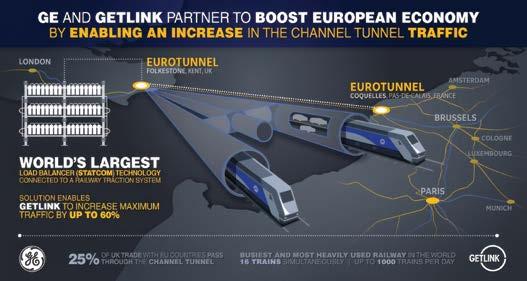
“By improving the efficiency of the infrastructure and increasing the number of trains running through the tunnel, this new technological advance will support our ambitious target of carrying 30 million passengers a year by 2030 across our network.”
GE custom-designed and supplied the entire STATCOM system, including its adaptive SmoothSine control system, which provides the Eurotunnel with reactive power compensation and an improved range of operational voltage, leading to faster response times. Additionally, this technology has a smaller physical footprint than traditional Static Var Compensation (SVC)² systems.
GE is a leader in the industry in developing high-voltage grid solutions, including STATCOM, SVC, Series Compensation Systems, and Synchronous Condensers—resulting in project cost savings, increased quality, greater reliability, and lower environmental impact.
ABOUT GE’S GRID SOLUTIONS
Grid Solutions, a GE Renewable Energy business, serves customers globally with over 13,000 employees. It provides power utilities and industries worldwide with equipment, systems and services to bring power reliably and efficiently from the point of generation to end power consumers. Grid Solutions is focused on addressing the challenges of the energy transition by enabling the safe and reliable connection of renewable and distributed energy resources to the grid. GE Grid Solutions aims to electrify the world with advanced grid technologies and accelerate the energy transition.
1 STATCOM = Static Synchronous Compensator, technology allowing voltage stability, power transfer capability and reactive power balance in a grid.
30 Highway Engineering Australia | Feb/Mar 2023 INNOVATIVE SOLUTIONS
2 SVC = Static Var Compensation, technology used since the early 1970s, reliable means of controlling voltage over transmission lines and improving network dynamic stability while increasing power transfer capability.






Flatlining Sales? ADVERTISING WORKS! (After all, you’re reading this aren’t you?) CALL US TODAY and find out how we can help you 1300 EPC GROUP (1300 372 476) e: ats@epcgroup.com www.epcgroup.com
MODERN AND SAFE UPGRADE CALLS FOR PRECAST

Project: Pymble Station lifts
Location: Pymble, NSW
Master Precaster: Waeger
Constructions
Head contractor: Laing O’Rourke
Improving accessibility was high on the agenda of a recent upgrade to the rail station at Pymble on Sydney’s North Shore. A part of Transport for New South Wales’ Transport Access Program, the upgrade will ultimately provide a better experience for public transport
customers by delivering modern, safe and accessible infrastructure.
As a busy suburban station, the construction of two new lifts that connect the Pacific Highway, Grandview Street and the station platforms to the existing footbridge was always going to be a challenge.
Expediting construction schedules called for the lift shafts to be manufactured offsite in precast concrete and installed overnight.
Master Precaster Waeger Constructions manufactured the lift shafts in their Hunter Valley factory, and National Precast CEO Sarah Bachmann says precast can be very useful when it comes to construction in busy public areas.

PRECAST OVERCOMES CHALLENGES ASSOCIATED WITH INSITU
“Many projects located in busy urban areas specify precast because the alternative - insitu construction - can be problematic because of the congestion and interruptions caused by site materials’ deliveries, longer construction works’ programmes, waste removal, noise and dust that come with it.
“They can all be overcome by using precast concrete, and this project is case in point,” Ms Bachmann commented.
“By manufacturing the lift shafts offsite at the Waeger factory, construction activity was removed from the site, thereby making it safer. Installation then was able to be scheduled at night when the public – and in this case commuters – were not around,” Ms Bachmann added.
Two lift shafts were manufactured for the project, in a Class 2 off-form finish with chamfered edges.
According to Waeger Managing Director, Michael Waeger, most of the elements under this contract were to be installed within the live rail corridor, within or adjacent to existing stations.
“Difficulties working close to the travelling public, close to passing trains, and near to or beneath live overhead high voltage wires were all overcome by supplying these items as precast. They were installed in a single fourhour installation session during an overnight rail shutdown,” Mr Waeger said.
32 Highway Engineering Australia | Feb/Mar 2023 NATIONAL PRECAST NEWS
DELIVERY TO COMPLY WITH NATIONAL HEAVY VEHICLE (NHV) REGULATIONS
Mr Waeger added that aside from facilitating the installation, which was undertaken by the head contractor, coordinating the delivery of multiple very large precast elements within the requirements of National Heavy Vehicle law was certainly the most challenging aspect of the contract.

“We managed to comply with NHV regulations in cooperation with our experienced transport partners, who provided advice on the measures that were required to comply with NHV regulations,” Mr Waeger said.
“Each of the loadbearing lift shafts weighed over 29 tonnes and measured more than three metres square at their base, by 3.3 metres high – that took some co-ordination. We needed pilot vehicles for each load, and travel times were restricted to the permitted window of 21:00 PM to 05:00 AM on the day of installation,” he said.
IN-FACTORY WATERPROOFING TO SPEED PROGRAMME

To assist with timely installation, Waeger Constructions facilitated another of Laing O’Rourke’s subcontractors to waterproof the lift shafts within their factory prior to loading and transporting to site.
“This saved significant time in the installation works as originally it was planned to waterproof between unloading and installing the lift shafts to their final position,” Mr Waeger added.
SPEEDING CONSTRUCTION AND DELIVERING COST EFFICIENCIES
Manufacturing the lift shafts as precast certainly sped the construction programme, the savings from which – while not specifically quantified –would have been significant. The alternative logistical issues that would have accompanied efforts to deliver, place, form and pour these significant structures insitu, within the live rail corridor, beneath high voltage lines and alongside moving trains and the travelling public, would have been extreme. And so too, would have been the cost associated with overcoming these obstacles in a fashion other than specifying precast construction.
The project is expected to be completed in 2023.
Feb/Mar 2023 | Highway Engineering Australia 33
WIRTGEN SHOWCASES TECHNOLOGIES FOR SUSTAINABLE ROAD CONSTRUCTION
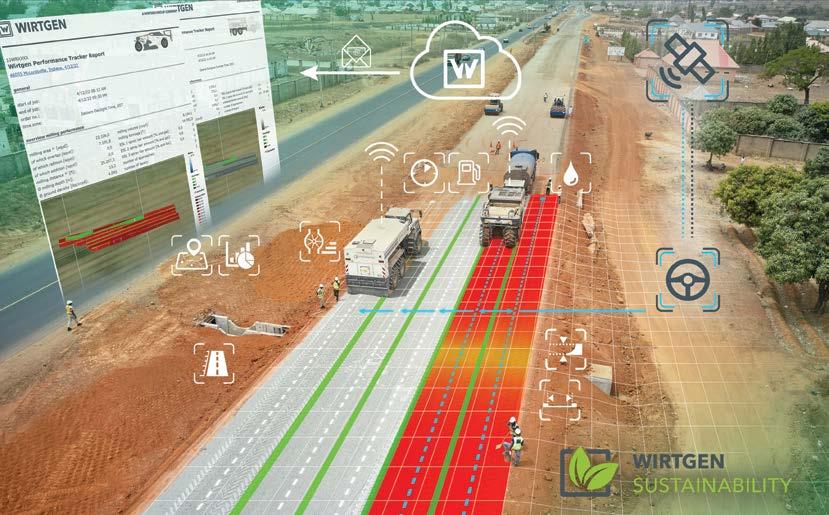
With an ever-increasing global focus on sustainability, road construction equipment powerhouse Wirtgen Group is placing an emphasis on increasing sustainability in sustainability in road construction, with a range of innovative solutions for cold milling, recycling, soil stabilising and concrete paving. Together with its focus on more sustainable road construction, Wirtgen’s latest range also focuses on digital solutions and assistance systems which increase both safety and productivity. The updated range will form the centrepiece of the company’s display at the upcoming CONEXPO-CON/AGG 2023 International Construction Trade Show in Las Vegas in March.
COLD MILLING FOR ALL CONSTRUCTION SITE SIZES
With the W 50 Ri, Wirtgen will present its powerful half-metre cold milling machine
with rear loading. Its winning features include a simple operating concept and automatic functions. The W 120 Fi front loader has been designed for working widths of up to 1.3 m.
The F-Series compact milling machine is fitted with a John Deere engine that has been customised to meet the special demands of cold milling applications. Two large F-Series milling machines complete the cold milling machine range on show.
A broad spectrum of applications can be covered using the W 210 Fi, spanning everything from surface layer rehabilitation or complete paving removal to fine milling work. The W 250 Fi, the most powerful large milling machine, was developed with an eye for material loading capacity and performance to maximise productivity.
F-Series cold milling machines are available with the innovative Mill Assist machine control system as well as the Wirtgen
Performance Tracker for digital construction site documentation.
COLD RECYCLING AND SOIL STABILISING – SUSTAINABLE AND ECONOMICAL
The responsible use of resources is a key element of the W 380 CRi as well as the WR 200 XLi and WR 250i. The W 380 CRi with rear loading and a mixing performance of up to 800 t/h is used for rehabilitating wide roads. It can be deployed in both cold in-place recycling (CIR) and in full-depth reclaiming (FDR) projects.
Besides cold recycling, the WR-Series wheel-driven recyclers can also carry out soil stabilising tasks. With a working width of 2.4 m, as well as high milling and mixing performances, they are well-equipped for use in demanding projects with high daily outputs.
34 Highway Engineering Australia | Feb/Mar 2023 EQUIPMENT FOCUS
Wirthgen’s AutoTrac and WPT systems make a significant contribution to resource conservation during soil stabilising.
The digital system solutions, the AutoTrac steering system and the WPT (Wirtgen Performance Tracker) documentation system further increase process efficiency.
FLEXIBILITY DURING INSET AND OFFSET CONCRETE PAVING
With the SP 15i and SP 94i, Wirtgen will showcase two very customisable concrete paving machines.
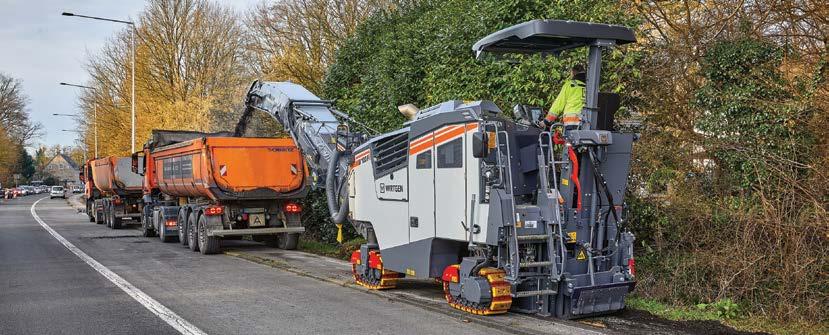
The SP 15i allows flexible slipform paver positioning, which is a huge advantage when producing monolithic profiles in an offset process. The machine also has a telescopic operating platform extension for a better view of the working area and the paving result.
Furthermore, the machine can be controlled without a stringline, using the specially developed AutoPilot 2.0 control system.
The SP 94i is a fully modular inset slipform paver in the 9.1m class. The 4-crawler paver with the TeleMold system will also be presented in Las Vegas. This paver allows fast and flexible working width changes up to 915mm on each side, making a total of 1.83m.
INNOVATIVE COLD MILLING TECHNOLOGIES
The Mill Assist machine control system increases process efficiency during cold
milling. In automatic mode, this system establishes an optimum ratio between performance and operating costs. The engine speed and milling drum speed are controlled automatically.
The lower speed range enables fuel consumption and pick wear to be significantly reduced. In the upper speed range, an optimum milling pattern can be achieved, even in the case of higher area performance rates. The operator can also select one of three operating strategies, ‘ECO’, ‘performance-optimised’ or ‘milling pattern quality’.
The milling performance can be documented precisely and reliably using Wirtgen Performance Tracker (WPT). The laser scanner defines the cross-sectional profile to be milled. Surface milling performance and milling volume are then precisely defined using GPS positioning and other sensors. Important information is displayed on the machine’s control panel and an automatically generated report can be sent by email to the machine operator, reducing the time and costs involved in job processing.
Cold milling expert Tom Chastain from Wirtgen America will provide an in-depth look at milling and profiling best practices and technologies during the CONEXPO Education Sessions that will be held in conjunction with the trade show in the Las Vegas Convention Center.
RESOURCE-SAVING TECHNOLOGIES FOR RECYCLING AND SOIL STABILISING
The satellite-based AutoTrac steering system used in Wirtgen WR-Series recyclers makes precise and efficient project processing easier. It steers the machine accurately within tolerances of a few centimetres on the basis of a previously determined reference strip and a specified overlap of adjacent strips, enabling consistent utilisation of the machine’s ideal working width. This results in greater process efficiency and, therefore, a higher degree of environmental compatibility.
The Wirtgen Performance Tracker is also available with WR-Series machines. The system balances all relevant working parameters on a site-specific basis to provide a comprehensive database for construction site analysis and documentation. For soil stabilising projects, this includes working width and depth, area and distance worked, fuel consumptiwon, and much more.
NON-STRINGLINE CONTROL INCREASES EFFICIENCY AND SAFETY
AutoPilot 2.0 is a control system developed by Wirtgen for non-stringline paving as an alternative to conventional scanning along a stringline. The system, which precisely controls both the machine’s height adjustment and steering, is available for all offset pavers and placers/spreaders.
A GNSS signal and, depending on the configuration, various local sensors, such as an ultrasonic sensor on the machine, act as a reference. The stringline is completely eliminated, and with it, the time needed to set it up and take it down. It also enables fast and precise paving of tight radii and complex geometries.
The Wirtgen AutoPilot 2.0 system provides machine control and remote control from a single source.
For further information on the full Wirtgen equipment range, visit: www.wirtgen-group.com
 Wirtgen F-Series compact and large milling machines are available with Mill Assist and Wirtgen Performance Tracker.
Wirtgen F-Series compact and large milling machines are available with Mill Assist and Wirtgen Performance Tracker.
Feb/Mar 2023 | Highway Engineering Australia 35 EQUIPMENT FOCUS
The Wirtgen AutoPilot 2.0 increases process efficiency and safety for non-stringline paving.
So too, the Engineer can use the vast capacity of Finite Element analysis to validate, optimize and adapt data to create the finest design solutions.








Just as Conductors use all the instruments at their disposal to create the finest music... www.if3.com.au
iPAVE ASSISTING VICTORIA'S POST-FLOOD ROAD RECOVERY

World-first technology is being used to assess the condition of Victoria’s flood-ravaged roads as part of the Victorian State Government’s emergency road repair blitz.
In January, Victorian Minister for Roads and Road Safety Melissa Horne announced that the Australian Road Research Board (ARRB)’s Intelligent Pavement Assessment Vehicle (iPAVE) was joining the blitz, assessing the condition of more than 8,400 kilometres of Victoria’s roads in the wake of recent floods and extreme rainfall, gathering a broad spectrum of data.
The collected data will help plan for upcoming large-scale repairs and road maintenance across both regional and metropolitan Victoria.
Equipped with a range of data collection systems, iPAVE is capable of assessing both the structural and functional condition of the road, using laser technology to look at characteristics including roughness, surface texture and rutting.
Cracking and other surface data is assessed using an automated 3D monitoring system, while cameras mounted to the truck’s exterior will give road maintenance experts a first-hand look at the state’s road network.
Thanks to an on-board ground-penetrating radar, the newest iPAVE in ARRB’s fleet can also collect sub-surface data at the same time, giving experts a better understanding of what’s happening underneath the road surface.
These datasets are collected at the same time, in one trip, at highway speed, making the iPAVE a cheaper, faster and safer way to collect intelligence. Data collected as part of iPAVE’s most recent assessments will then be compared with similar information collected in 2021 to gauge the full impact of the recent floods.
More than 170 of the state’s roads will undergo inspection by iPAVE, including major freight and tourist routes like the Hume, Western, Midland, Goulburn Valley and Calder highways.
Thanks to the Victorian Government’s $165 million emergency road repair blitz, larger-scale repairs are already underway on a range of roads right across the state, with more to come as warmer, drier weather delivers more suitable conditions for major roadworks.
Since mid-October, a team of more than 500 workers has repaired more than 116,000
potholes and delivered emergency repairs to re-open more than 930 roads – both local and state-managed roads.
“We’re using the latest technology to make sure we deliver the repairs needed right across our roads following the devastation caused by recent floods and extreme rainfall,” the Minister said.
“Already, crews are making a start on delivering large-scale, long-term repairs, and this data will help to plan for further works, ensuring that the communities hit hardest by these floods remain connected to vital supplies and services.”
ABOUT iPAVE
ARRB’s Intelligent Pavement Assessment Vehicle (iPAVE) is changing the way local governments and road agencies are managing their road assets.
An engineering masterpiece, the iPAVE vehicles consist of a prime mover and trailer equipped with a heavy weight over a single rear axle. A series of lasers mounted in the trailer measure the deflection velocity of the pavement in the left-hand wheel path as the truck travels down the road at highway speeds. This information is used to assess the bearing capacity of the pavement.
iPAVE vehicles can also measure roughness, texture, rutting, and capture digital imagery for visual ratings and ACD cracking.
USING THE SYDNEY BUS NETWORK TO FIND POTHOLES
The National Transport Research Organisation (NTRO) has been undertaking cuttingedge work through its road arm ARRB on identifying potholes and other ride quality issues around Sydney.
NTRO has been working with Cisco and the University of NSW to trial a new live real-time road condition monitoring system using Cisco routers fitted to public buses operating in the Sydney metropolitan area. The team was undertaking the work for Transport for NSW.
The system uses the readings from an accelerometer in the router mounted to the Sydney bus fleet as a surrogate for roughness, using the information to locate road anomalies based on real-time changes to the ride quality across the road network. For example, the bus experiences a spike in acceleration when it traverses a pothole or other pavement defect.
The results are overlayed on a map and displayed as a heat map, showing locations along the bus routes where the acceleration has consistently spiked, and investigation needs to be carried out.
NTRO collected roughness data across a portion of the network to help validate the model.
Results have been very successful so far, and the concept was demonstrated at the Cisco Live event in Melbourne in December.
AND ROAD ISSUES
NTRO/ARRB also displayed one of its ride quality vehicles at the event, with NTRO infrastructure measurement discipline lead Richard Wix attending along with NTRO/ARRB’s Marcus John and Daniel Siu.

38 Highway Engineering Australia | Feb/Mar 2023 NTRO | ARRB NEWS
Richard Wix and Marcus John from NTRO/ARRB, with one of the Ride Quality Vehicles at the recent Cisco Live event in Melbourne.
The Road to Relevant Research
AWARD-WINNING TRISIGN RECEIVES TIPES CERTIFICATION
Safetek Solutions’ award-winning TriSign has successfully received the Transport Infrastructure Product Evaluation Scheme (TIPES) certification.
Recently receiving the 2022 3M-ACRS Diamond Road Safety Award, TriSign is a changeable multiple message frame, allowing site engineers and traffic controllers the facility to quickly and remotely change the sign scheme of a traffic management worksite.
Adam Gardiner of SystemisedbyDesign, has overseen TriSign’s journey through the three phases of the TIPES certification process - application, panel evaluation and field evaluation. He explains:
“TriSign was inspired by our goal to eliminate the dangers to road workers during the periods of highest risk on a work site- set up and pack up of signs and devices,”
“Our journey through TIPES has been supported in no small way by DoT Victoria, Major Road Projects Victoria (MRPV), Seymour Whyte and McConnell Dowell.
“From concept through to approvals, TriSign has been a long journey for us, but is now a device that can bring safety, efficiency and convenience to the many project crews working on Australian roads each day.”
Providing an independent fit-for-purpose assessment of innovative road infrastructure products and devices, TIPES has recently awarded certification for the likes of Polyroad, the Australian Gibney Barrier, and Portaboom, and a number of high friction and coloured surface treatment materials.
ARRB’s Technical Secretary on the evaluation of TriSign, Karen Cogo, is thrilled with TriSign being the next certified road product with it increasing safety for traffic controllers.
“TriSign has the primary objective of considerably reducing the cumulative exposure of Traffic Controllers to being impacted by any off path or errant vehicle and in turn, reducing any disruption of traffic flow,” Ms Cogo said.
“The TIPES Product Evaluation Panel’s opinion is that the applicant had successfully demonstrated that the product is a practical solution which can considerably reduce the exposure to a traffic controller of an impact with live traffic, when compared to changing traditional, manual multi-message frame signage.”

TriSign has been used in Queensland since its inception on a project trial basis and is currently being used on a major long term, road project in Victoria.
Of the latter, Brian McInerney, Traffic Manager at Major Road Projects Victoria (MRPV) said, “We have two elements of the project that have minimal safe verges for traffic crews to safely set and pack up signage each day. We identified TriSign as a new product that could eliminate this risk by remotely changing signs each shift as well as the other benefits that the product brings.”
Mark Steidle, Governance Manager of TIPES, is also enthused by the collaborative manner in which this truly innovative and effective product has ultimately progressed to certification. Mr Steidle said: “MRPV expressed an early interest in the product, and this allowed the proponent to fine-tune their submission and focus on end-requirements and optimising benefits.”
“SystemisedbyDesign showed a genuine passion in their product and making an impact, and this was recognised by the PEP. Adam and his team responded immediately to all requests for additional information or if there were any technical questions, and this is important in the journey to certification,” Mr Steidle added.
Did you know you can access the latest issue of Highway Engineering Australia via Informit?
The Informit Engineering Collection is an ever expanding resource covering aspects of highway engineering - planning and development, design, construction, maintenance and management. The database offers an extensive variety of resources including journals, trade publications, reports and conference proceedings.
The Collection guarantees quality through partnerships with peak professional bodies including Engineers Australia and the Institution of Professional Engineers New Zealand, as well as Content Providers including EPC Media Group.

The Informit Engineering Collection delivers hard to find content designed to complete and complement your highway engineering requirements.

Other key titles published by EPC Media include:
Construction Engineering Australia Waste + Water Management Australia
Request a quote or free trial via www.informit.org/trial-and-quote
Research for your global future
Feb/Mar 2023 | Highway Engineering Australia 39
WHERE AND WHEN TO PUT OVERTAKING LANES ON TWOWAY, TWO-LANE
RURAL ROADS
Changing lifestyles and the surge in development outside Australia’s major cities mean two-way, two-lane rural roads are carrying more vehicles than ever.
Sea changers and tree changers, as well as increased development on our city fringes, means two-lane rural roads are seeing growth in traffic volumes that may not have been predicted when they were initially planned and built.
ARRB's new Rural Overtaking Assessment Modelling tool (ROAM) can help assess the level of service and overtaking opportunities to inform planning and investment works for rural roads.
ROAM offers visualisation of the mapping of survey data, which allows for improved auditing of input road attributes. With visualisation comes a deeper understanding and insight into how vehicles are operating on
SUBSCRIBE
YES! I wish to receive a print subscription to
roads based on the modelling. This allows road managers to better plan and develop their assets in a cost-effective and affordable way.
Benefits of ROAM:
• Unique software that models entire roads based on their actual geometry, as collected by ARRB survey vehicles;

• Traffic simulated as it behaves on the road based on the horizontal and vertical curves and gradients, sight distances and available overtaking opportunities;


• This allows the model to determine where along the road platooning typically occurs due to faster vehicles becoming impeded behind slower vehicles;
• It is a system approach to modelling traffic along a specific road that other simulation software cannot easily replicate.


NTRO/ARRB has produced a Webinar explaining ROAM, and how it can benefit road managers. Access the Webinar at: https:// www.arrb.com.au/news/where-and-whento-put-overtaking-lanes-on-two-way-ruralroads

40 Highway Engineering Australia | Feb/Mar 2023 NTRO | ARRB NEWS















QUALITY EQUIPMENT SUPPORT SERVICE Whatever your line marking or tra c management requirements, A1 Roadlines has the equipment and expertise to meet your needs. THE EQUIPMENT YOU NEED – THE SERVICE YOU EXPECT A1 Roadlines Pty Ltd | 89 Rushdale Street, Knoxfield, Victoria 3180 | www.a1roadlines.com.au P: 1300 217 623 (A1ROAD) | F: (03) 9765 9499 | E: sales@a1roadlines.com.au




www.steelcertification.com Ph: (02) 9965 7216 E: info@steelcertification.com ABN: 40 096 692 545 certificate – giving you confidence in the conformity of your steel supply. ACRS - Independent, Expert Third Party Certification and Verification of Reinforcing, Prestressing and Structural Steels for Compliance with Australian and New Zealand Standards
































































































 Transition Test #1 for 2270kg Ute
Transition Test #2 for 2270kg Ute
Transition Test #3 for 2270kg Ute
Transition Test #1 for 900kg Sedan
Transition Test #1 for 13,000kg Bus
Transition Test #1 for 2270kg Ute
Transition Test #2 for 2270kg Ute
Transition Test #3 for 2270kg Ute
Transition Test #1 for 900kg Sedan
Transition Test #1 for 13,000kg Bus

































 Wirtgen F-Series compact and large milling machines are available with Mill Assist and Wirtgen Performance Tracker.
Wirtgen F-Series compact and large milling machines are available with Mill Assist and Wirtgen Performance Tracker.
































